计算机网络_图论
图论在计算机网络中的应用
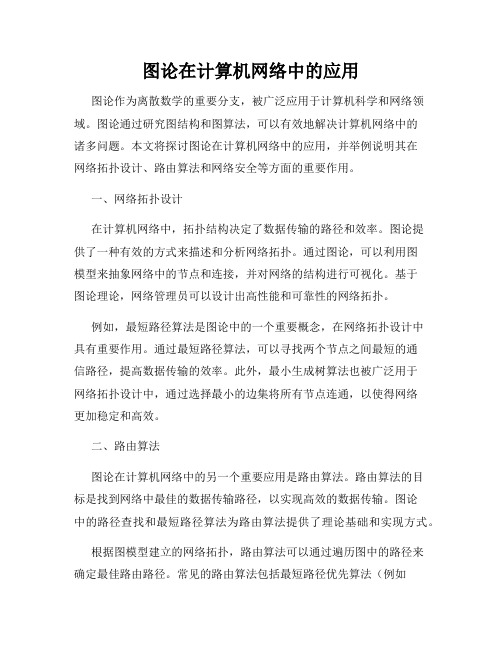
图论在计算机网络中的应用图论作为离散数学的重要分支,被广泛应用于计算机科学和网络领域。
图论通过研究图结构和图算法,可以有效地解决计算机网络中的诸多问题。
本文将探讨图论在计算机网络中的应用,并举例说明其在网络拓扑设计、路由算法和网络安全等方面的重要作用。
一、网络拓扑设计在计算机网络中,拓扑结构决定了数据传输的路径和效率。
图论提供了一种有效的方式来描述和分析网络拓扑。
通过图论,可以利用图模型来抽象网络中的节点和连接,并对网络的结构进行可视化。
基于图论理论,网络管理员可以设计出高性能和可靠性的网络拓扑。
例如,最短路径算法是图论中的一个重要概念,在网络拓扑设计中具有重要作用。
通过最短路径算法,可以寻找两个节点之间最短的通信路径,提高数据传输的效率。
此外,最小生成树算法也被广泛用于网络拓扑设计中,通过选择最小的边集将所有节点连通,以使得网络更加稳定和高效。
二、路由算法图论在计算机网络中的另一个重要应用是路由算法。
路由算法的目标是找到网络中最佳的数据传输路径,以实现高效的数据传输。
图论中的路径查找和最短路径算法为路由算法提供了理论基础和实现方式。
根据图模型建立的网络拓扑,路由算法可以通过遍历图中的路径来确定最佳路由路径。
常见的路由算法包括最短路径优先算法(例如Dijkstra算法)和距离矢量路由算法(例如RIP算法)。
这些算法利用图论的思想,解决了计算机网络中的路由选择问题,提高了网络的传输效率和稳定性。
三、网络安全图论在网络安全领域也有广泛的应用。
网络攻击和入侵检测是当今网络面临的重大挑战,图论提供了一种分析和识别网络攻击的方法。
通过建立攻击图模型,可以将网络中的各个节点和攻击路径以图的形式表示,从而更好地理解和分析潜在的威胁。
此外,图论也可用于网络拓扑的弱点分析。
通过构建拓扑结构图,可以识别网络的薄弱环节,并采取相应的安全措施。
例如,通过追踪网络中的关键节点和连接,可以有效地发现并防止任何潜在的攻击行为。
图论与网络

图论与网络引言在数学的广阔领域中,图论是一颗璀璨的明珠。
它不仅是数学的一个分支,也是计算机科学、物理学、化学等多个学科的基础工具。
图论通过图形来表示对象之间的二元关系,这些对象可以是人、地点或者任何可以被抽象为点的实体,而它们之间的关系则由连接两点的线(边)表示。
网络,作为图论中的一个重要概念,指的是由节点和连接节点的边构成的系统,它在现代社会中的应用日益广泛,从社交网络到互联网,从交通网络到神经网络,无不体现了图论的巨大价值。
图论的基本概念图论中的“图”是由顶点(Vertex)和边(Edge)组成的。
顶点代表图中的个体,而边则代表了个体之间的联系。
根据边是否有方向,图可以分为无向图和有向图;根据边是否有权值,图又可以分为无权图和加权图。
此外,图中顶点的度是指与该顶点相关联的边的数量,而在有向图中,入度和出度分别指进入和离开顶点的边的数量。
网络的分类网络可以根据其结构特性被分为多种类型。
最常见的分类包括:规则网络、随机网络、小世界网络和无标度网络。
规则网络中的节点按照固定规则连接,如环形或网格形;随机网络则是通过随机过程连接节点形成的;小世界网络结合了规则网络的高集聚系数和随机网络的短平均路径长度;而无标度网络的特点在于节点的度分布遵循幂律分布,这意味着网络中存在少数几个高度连接的枢纽节点。
图论的应用图论在现实世界中的应用极为广泛。
例如,在社交网络分析中,人们利用图论来研究人际关系的模式和动态;在网络科学中,图论帮助研究者理解互联网的结构和发展;在运筹学中,最短路径问题、最大流问题等都可以用图论的方法来解决。
此外,图论还在生物信息学、电力网设计、任务调度等多个领域发挥着重要作用。
结语图论与网络作为一门古老而又年轻的学科,正以其独特的魅力吸引着越来越多的关注。
随着科技的发展和社会的进步,图论的理论和应用必将进一步拓展,为我们解决更多实际问题提供强大的工具和方法。
通过学习和掌握图论的知识,我们能够更好地理解和改造这个由无数节点和连接构成的复杂世界。
计算机网络中的网络拓扑分析方法

计算机网络中的网络拓扑分析方法计算机网络是现代社会中必不可少的一部分,它连接了世界各地的计算机,促进了信息的传递和共享。
而网络拓扑则是计算机网络中一个重要的概念,它描述了网络中各个节点和连接之间的关系。
在网络设计、优化以及故障排除等方面,网络拓扑的分析是至关重要的。
本文将介绍计算机网络中的网络拓扑分析方法,以帮助读者更好地理解和应用网络拓扑。
一、基本概念网络拓扑是网络中节点和连接的布局方式,它描述了网络中各个节点之间的物理或逻辑关系。
常见的网络拓扑类型有星型、总线型、环型、树型、网状等,每种拓扑类型都有其优势和局限性。
网络拓扑的分析包括了拓扑结构的建模和拓扑分析的两个方面。
二、网络拓扑的建模在进行网络拓扑分析之前,首先需要对网络中的节点和连接进行建模。
建模的目的是将网络中复杂的结构抽象成易于理解和处理的形式。
常用的网络拓扑建模方法有以下几种:1. 矩阵法矩阵法是一种简洁而直观的网络拓扑建模方法。
通过构建一个邻接矩阵,可以清晰地表示出节点之间的连接关系。
矩阵中的每个元素代表了相应节点之间的连接状态,可以是有连接、无连接或者其他状态。
2. 图论法图论法是一种抽象化的网络拓扑建模方法,通过图来表示网络中的节点和连接。
在图中,节点用圆圈表示,连接用线段表示。
通过在图中添加节点和连接,可以清晰地表达出网络的拓扑结构。
3. 链表法链表法主要用于描述线性拓扑结构,例如总线型和环型拓扑。
通过将节点和连接按照顺序连接起来,可以形成一个链表。
链表的头表示网络的起点,链表的尾表示网络的终点。
三、网络拓扑的分析网络拓扑的分析是指对网络拓扑结构进行定性和定量的研究,以获得有关网络性能和可靠性的信息。
网络拓扑的分析结果可以用于网络设计、优化和故障排除等方面。
1. 性能分析性能分析是网络拓扑分析的一项重要内容,它研究网络中数据传输的效率和延迟等性能指标。
常见的性能指标包括带宽、吞吐量、时延和丢包率等。
通过性能分析,可以评估网络的负载能力、瓶颈位置和优化策略。
图论与网络算法
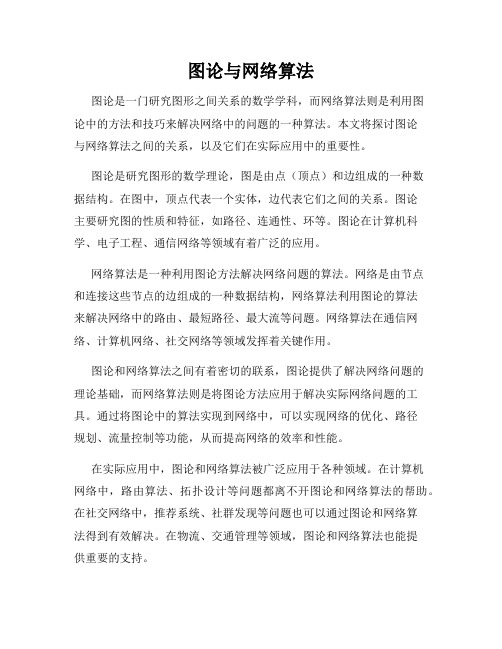
图论与网络算法图论是一门研究图形之间关系的数学学科,而网络算法则是利用图论中的方法和技巧来解决网络中的问题的一种算法。
本文将探讨图论与网络算法之间的关系,以及它们在实际应用中的重要性。
图论是研究图形的数学理论,图是由点(顶点)和边组成的一种数据结构。
在图中,顶点代表一个实体,边代表它们之间的关系。
图论主要研究图的性质和特征,如路径、连通性、环等。
图论在计算机科学、电子工程、通信网络等领域有着广泛的应用。
网络算法是一种利用图论方法解决网络问题的算法。
网络是由节点和连接这些节点的边组成的一种数据结构,网络算法利用图论的算法来解决网络中的路由、最短路径、最大流等问题。
网络算法在通信网络、计算机网络、社交网络等领域发挥着关键作用。
图论和网络算法之间有着密切的联系,图论提供了解决网络问题的理论基础,而网络算法则是将图论方法应用于解决实际网络问题的工具。
通过将图论中的算法实现到网络中,可以实现网络的优化、路径规划、流量控制等功能,从而提高网络的效率和性能。
在实际应用中,图论和网络算法被广泛应用于各种领域。
在计算机网络中,路由算法、拓扑设计等问题都离不开图论和网络算法的帮助。
在社交网络中,推荐系统、社群发现等问题也可以通过图论和网络算法得到有效解决。
在物流、交通管理等领域,图论和网络算法也能提供重要的支持。
总之,图论与网络算法在现代社会中起着重要的作用,它们为解决各种实际问题提供了有力的工具和方法。
通过深入研究图论和网络算法,可以更好地理解和应用它们,从而推动各个领域的发展与进步。
我们应该重视图论与网络算法的学习和应用,不断探索它们在各个领域的潜力,为建设智能化、高效化的社会作出贡献。
网络图论和网络方程

T2连:{2支,3,集5}1
L2:{1,4,6}
a a
b
4 5
3 c
T3树:{3余,4,5}
d b
L3:{1,2,6}
4 5
cT4树:{1余,5,4}
d L4:{2,3,6}
五、回路和 基本回路
回路: 从图中的某一个顶点出发,沿着边和顶点 不重复地巡行一周回到原出发的顶点所得到的闭合路径称 为回路。回路数用M表示。
1
a 3 b4 c
2
56
如 a3 b
i3 + u3 -
d
有向图G
(1) 图中各边的方向与所对应电路中各元件上的电
流方向一致;
(2)取各支路的电压与电流方向为关联方向。
3. 子图和补图 实例
1
1
a 3 b4 c =a 3 b
2 56
2
c +b 4
c
G1和G2 的总和包括
5 6 了G 的全部
支路和节点。
(2) 连支:对一个图G 除去所选树的树支以外的每个
支路称为连支,用L支表示。
(3)树余(连支集):与树互补的子图称为树余,又称
连支集,用L表示。
如
1
3 b4
a
a
c
2 56
2
b c
56
a 3b c
56
d
d
d
T1:{2,5,6}
T2:{3,5,6}
G
树支:T支为2,5和6 连支:L支为1,3和4
LT支支为为13,,25和和46
B1 {2,4,6} B2 {3,5,6}
B3 {1,4,5} B4 {2,3,4,5}
电路第十章 网络图论及网络方程
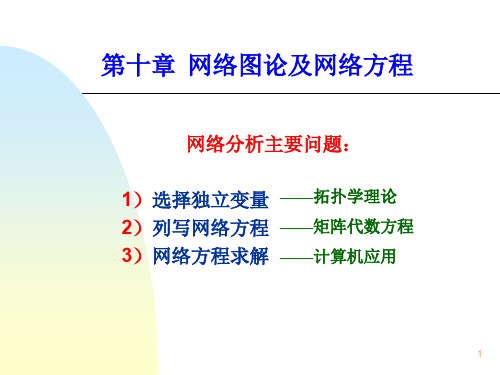
8
1 0 0 0 0 -1 0 0 1 0 0
习题0 :110-07 0求0Bf、1 C-1f -1 0 -1
1
[C
f
]
0 0 1 0 010 0树支0:10、21、30、05、19
-1 1
0 -1
0 0
1 0
0 0 0 0 1 0 0 0 0 1 -1
2、基本割集关联矩阵Cf
7
四、A、Bf、Cf关系
1 0 0 1 1 0
选一棵对树于,一支个路有编向号图,[A] 0 1 1 1 0 0
先树支后连支。则有: 0 0 1 0 1 1
A At Al
B Bt Bl Bt 1
1 1 0 1 0 0 [Bf ] 1 1 1 0 1 0
1 4
2 3
5
21
10-5 基本割集法
一、标准支路伏安关系
Ik Yk Uk Yk Usk Isk
二、矩阵形式支路伏安关系:
Ib Yb Ub Yb Us Is
其中: Yb : 支路导纳矩阵
三、支路电流关系:
Cf Ib 0
i1 - i4 + i6 = 0 i2 + i4 + i5 = 0
3
2、回路(Loop)
回路是连通图G的一个子图, 满足:
1)连通图
2)每个节点仅关联两条支路
3)移去任一支路,则无闭合 路径
基本回路:单连支回路,连支方向为回路方向。
3、割集(Cut) 割集是连通图G的一些支路的集合,满足: 1)移去该支路集合,则图恰好分成两部分;
离散数学中的图论应用
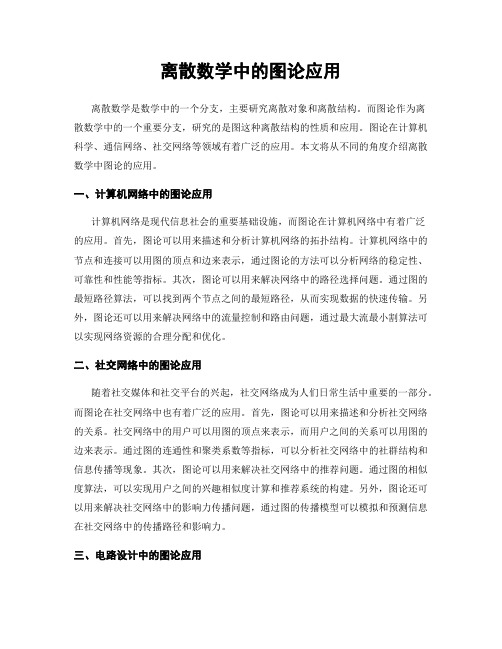
离散数学中的图论应用离散数学是数学中的一个分支,主要研究离散对象和离散结构。
而图论作为离散数学中的一个重要分支,研究的是图这种离散结构的性质和应用。
图论在计算机科学、通信网络、社交网络等领域有着广泛的应用。
本文将从不同的角度介绍离散数学中图论的应用。
一、计算机网络中的图论应用计算机网络是现代信息社会的重要基础设施,而图论在计算机网络中有着广泛的应用。
首先,图论可以用来描述和分析计算机网络的拓扑结构。
计算机网络中的节点和连接可以用图的顶点和边来表示,通过图论的方法可以分析网络的稳定性、可靠性和性能等指标。
其次,图论可以用来解决网络中的路径选择问题。
通过图的最短路径算法,可以找到两个节点之间的最短路径,从而实现数据的快速传输。
另外,图论还可以用来解决网络中的流量控制和路由问题,通过最大流最小割算法可以实现网络资源的合理分配和优化。
二、社交网络中的图论应用随着社交媒体和社交平台的兴起,社交网络成为人们日常生活中重要的一部分。
而图论在社交网络中也有着广泛的应用。
首先,图论可以用来描述和分析社交网络的关系。
社交网络中的用户可以用图的顶点来表示,而用户之间的关系可以用图的边来表示。
通过图的连通性和聚类系数等指标,可以分析社交网络中的社群结构和信息传播等现象。
其次,图论可以用来解决社交网络中的推荐问题。
通过图的相似度算法,可以实现用户之间的兴趣相似度计算和推荐系统的构建。
另外,图论还可以用来解决社交网络中的影响力传播问题,通过图的传播模型可以模拟和预测信息在社交网络中的传播路径和影响力。
三、电路设计中的图论应用电路设计是电子工程中的一个重要领域,而图论在电路设计中有着广泛的应用。
首先,图论可以用来描述和分析电路的拓扑结构。
电路中的器件和连接可以用图的顶点和边来表示,通过图论的方法可以分析电路的稳定性、功耗和延迟等指标。
其次,图论可以用来解决电路中的布线问题。
通过图的最小生成树算法和最短路径算法,可以实现电路的布线优化和信号传输的最优化。
计算机科学典型问题示例

计算机科学典型问题示例计算机科学是研究计算机及其周围各种现象和规律的科学,亦即研究计算机系统结构、程序系统、以及计算本身的性质和问题的学科。
下面,我们将通过几个典型问题来深入理解计算机科学的基本原理和挑战。
1、排序算法在计算机科学中,排序算法是一种经典的问题,它涉及到对一组数据进行有序排列。
常见的排序算法包括冒泡排序、选择排序、插入排序、快速排序、归并排序等。
每种算法都有其独特的原理和优缺点,适用的场景也不同。
例如,冒泡排序适合于小规模数据的排序,而快速排序则适合于大规模数据的排序。
2、图论图论是计算机科学中的一个重要分支,它研究的是图的性质和结构。
图论中的经典问题包括:欧拉路径问题、哈密尔顿回路问题、最大流问题、最小割问题等。
这些问题在理论和应用方面都有广泛的研究。
例如,哈密尔顿回路问题在解决旅行商问题中具有重要应用,而最大流问题则在解决网络流量问题中具有重要应用。
3、人工智能人工智能是计算机科学中的一个热门领域,它研究的是如何让计算机模拟人类的智能行为。
人工智能中的经典问题包括:图像识别、语音识别、自然语言处理、机器学习等。
这些问题需要计算机具备类似于人类的感知、认知和学习能力,是计算机科学中的前沿问题。
4、数据库系统数据库系统是计算机科学中的一个重要应用领域,它研究的是如何有效地管理和存储数据。
数据库系统中的经典问题包括:查询优化、事务处理、并发控制、数据恢复等。
这些问题需要计算机具备高效的数据存储和检索能力,同时也需要保证数据的安全性和完整性。
5、计算机网络计算机网络是计算机科学中的一个重要领域,它研究的是如何实现计算机之间的通信和资源共享。
计算机网络中的经典问题包括:路由选择、拥塞控制、数据传输、网络安全等。
这些问题需要计算机具备高效的通信能力和资源共享能力,同时也需要保证网络的安全性和稳定性。
以上这些问题是计算机科学中的典型代表,它们不仅仅是学术研究的重要课题,也在实际应用中具有重要的应用价值。
图论在计算机网络中的应用 案例解析
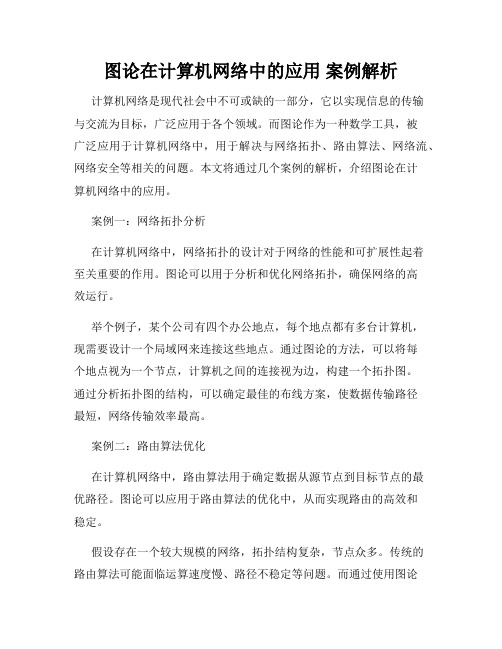
图论在计算机网络中的应用案例解析计算机网络是现代社会中不可或缺的一部分,它以实现信息的传输与交流为目标,广泛应用于各个领域。
而图论作为一种数学工具,被广泛应用于计算机网络中,用于解决与网络拓扑、路由算法、网络流、网络安全等相关的问题。
本文将通过几个案例的解析,介绍图论在计算机网络中的应用。
案例一:网络拓扑分析在计算机网络中,网络拓扑的设计对于网络的性能和可扩展性起着至关重要的作用。
图论可以用于分析和优化网络拓扑,确保网络的高效运行。
举个例子,某个公司有四个办公地点,每个地点都有多台计算机,现需要设计一个局域网来连接这些地点。
通过图论的方法,可以将每个地点视为一个节点,计算机之间的连接视为边,构建一个拓扑图。
通过分析拓扑图的结构,可以确定最佳的布线方案,使数据传输路径最短,网络传输效率最高。
案例二:路由算法优化在计算机网络中,路由算法用于确定数据从源节点到目标节点的最优路径。
图论可以应用于路由算法的优化中,从而实现路由的高效和稳定。
假设存在一个较大规模的网络,拓扑结构复杂,节点众多。
传统的路由算法可能面临运算速度慢、路径不稳定等问题。
而通过使用图论中的最短路径算法,如Dijkstra算法或Floyd-Warshall算法,可以高效地找到源节点到目标节点的最短路径,并避免出现环路和拥塞现象。
通过优化路由算法,可以提高网络的响应速度和数据传输的可靠性。
案例三:网络流分析在计算机网络中,网络流量的管理与控制也是一个重要的问题。
图论可以应用于网络流问题的分析与优化,以实现网络资源的合理利用与分配。
举个例子,某个企业的服务器集群面临着高负载的问题,需要合理调度服务器的负载,以避免出现过载现象。
通过使用图论中的最大流算法,如Ford-Fulkerson算法或Edmonds-Karp算法,可以确定最佳的流量分配方案,使每台服务器的负载达到均衡状态,提高整个网络的性能。
案例四:网络安全分析在计算机网络中,网络安全问题一直备受重视。
图论在计算机科学中的应用
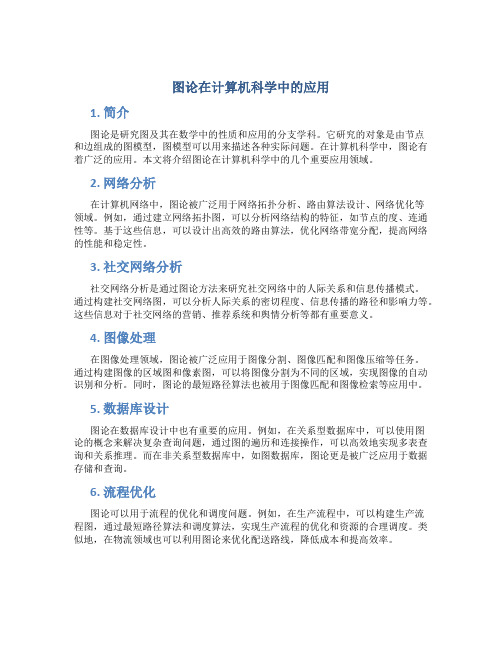
图论在计算机科学中的应用1. 简介图论是研究图及其在数学中的性质和应用的分支学科。
它研究的对象是由节点和边组成的图模型,图模型可以用来描述各种实际问题。
在计算机科学中,图论有着广泛的应用。
本文将介绍图论在计算机科学中的几个重要应用领域。
2. 网络分析在计算机网络中,图论被广泛用于网络拓扑分析、路由算法设计、网络优化等领域。
例如,通过建立网络拓扑图,可以分析网络结构的特征,如节点的度、连通性等。
基于这些信息,可以设计出高效的路由算法,优化网络带宽分配,提高网络的性能和稳定性。
3. 社交网络分析社交网络分析是通过图论方法来研究社交网络中的人际关系和信息传播模式。
通过构建社交网络图,可以分析人际关系的密切程度、信息传播的路径和影响力等。
这些信息对于社交网络的营销、推荐系统和舆情分析等都有重要意义。
4. 图像处理在图像处理领域,图论被广泛应用于图像分割、图像匹配和图像压缩等任务。
通过构建图像的区域图和像素图,可以将图像分割为不同的区域,实现图像的自动识别和分析。
同时,图论的最短路径算法也被用于图像匹配和图像检索等应用中。
5. 数据库设计图论在数据库设计中也有重要的应用。
例如,在关系型数据库中,可以使用图论的概念来解决复杂查询问题,通过图的遍历和连接操作,可以高效地实现多表查询和关系推理。
而在非关系型数据库中,如图数据库,图论更是被广泛应用于数据存储和查询。
6. 流程优化图论可以用于流程的优化和调度问题。
例如,在生产流程中,可以构建生产流程图,通过最短路径算法和调度算法,实现生产流程的优化和资源的合理调度。
类似地,在物流领域也可以利用图论来优化配送路线,降低成本和提高效率。
7. 算法设计许多算法和数据结构都依赖于图论的基本概念和算法。
例如,最短路径算法、最小生成树算法、拓扑排序算法等都是图论中的经典算法。
这些算法在计算机科学中有着广泛的应用,如路由算法、最优化问题求解、任务调度等领域。
8. 人工智能图论在人工智能领域也有重要的应用。
数学中的图论理论及其应用

数学中的图论理论及其应用图论是一门研究图形和网络的数学理论,它是数学中的一个分支,也是计算机科学中的一个重要领域。
图论的不断发展使其应用越来越广泛,尤其在计算机网络、社交网络、交通路线等方面有着广泛的应用。
一、图论的定义与性质图论中的“图”指的是一个有限的节点集合和与这些节点相关的边集合。
在图中,节点被称为顶点,边被称为边缘。
在一个无向图中,每条边连接两个节点,没有方向性;在有向图中,每条边都有一个方向,从一个节点指向另一个节点。
图所具有的一些性质,如连通性、路径、环等,可以用来研究现实世界中的许多问题。
例如,人际关系可以用图来表示,而在图中找到最短路径可以用来表示最小成本行程的问题。
二、图的表示方法图可以通过矩阵和链表两种方式进行表示。
矩阵表示法是将图中的节点和边分别用矩阵的元素表示,由于矩阵的性质,这种方法适用于表示边的权重,但对于节点的增加和删除比较麻烦。
链表表示法是将图中的节点和边分别用链表的形式表示,这种方法适用于动态改变图的结构。
三、最短路径算法最短路径算法是图论中的一个重要问题,它是计算图中两个节点之间最短路径的算法。
最短路径算法可以采用Dijkstra算法或Floyd算法进行计算。
Dijkstra算法是一种贪心算法,通过构建带权重的图来计算两个节点之间最短距离。
该算法的基本思想是从起点出发,按照距离最近的顺序找到与该节点相邻的节点,然后根据这些节点的权重更新起点到别的节点的距离,直至找到终点。
由于该算法使用优先队列来存储节点,因此对于大规模的节点数或边数较多的图,具有较好的计算效率。
Floyd算法是一种动态规划算法,通过构建带权重的图来计算两个节点之间最短距离。
该算法的基本思想是先计算任意两个节点之间的距离,然后再使用动态规划的思想,从中间节点出发更新两个节点之间的距离,直至找到终点。
由于该算法需要计算所有的两点之间的距离,因此对于较小规模的图具有优势。
四、最小生成树算法最小生成树算法是图论中另一个重要的问题,它是用来找到给定的无向联通图的一棵生成树,使得生成树中的边权和最小。
图论与网络知识点
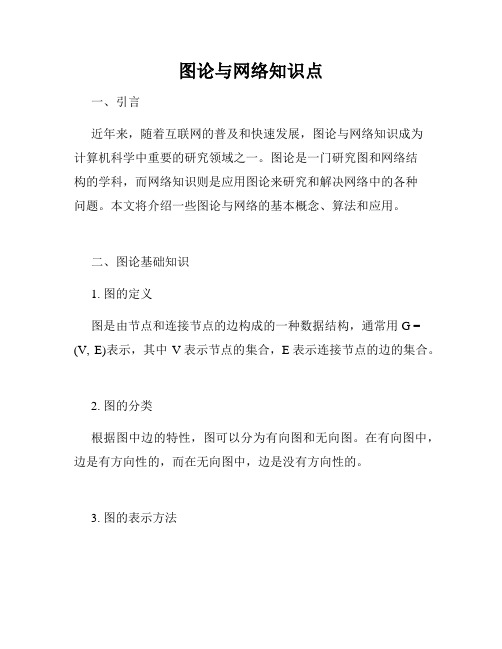
图论与网络知识点一、引言近年来,随着互联网的普及和快速发展,图论与网络知识成为计算机科学中重要的研究领域之一。
图论是一门研究图和网络结构的学科,而网络知识则是应用图论来研究和解决网络中的各种问题。
本文将介绍一些图论与网络的基本概念、算法和应用。
二、图论基础知识1. 图的定义图是由节点和连接节点的边构成的一种数据结构,通常用G = (V, E)表示,其中V表示节点的集合,E表示连接节点的边的集合。
2. 图的分类根据图中边的特性,图可以分为有向图和无向图。
在有向图中,边是有方向性的,而在无向图中,边是没有方向性的。
3. 图的表示方法图可以通过邻接矩阵或邻接链表进行表示。
邻接矩阵是一个二维数组,用于表示图中节点之间的连接关系;邻接链表是一种链表的形式,用于存储每个节点的相邻节点信息。
三、图论算法1. 最短路径算法最短路径算法用于找到两个节点之间最短路径的方法,其中最著名的算法是Dijkstra算法和Floyd-Warshall算法。
2. 拓扑排序拓扑排序用于对有向无环图中的节点进行排序。
拓扑排序算法常用于任务调度、依赖关系分析等场景。
3. 最小生成树算法最小生成树算法用于找到一棵树,使得树中所有边的权重和最小。
常用的算法包括Prim算法和Kruskal算法。
4. 最大流算法最大流算法用于找到网络中从源节点到目标节点的最大流量。
Ford-Fulkerson算法和Edmonds-Karp算法是常用的最大流算法。
四、网络知识点1. 网络拓扑结构网络拓扑结构指的是网络中节点之间连接的方式,常见的网络拓扑结构有星型结构、环型结构、总线结构、网状结构等。
2. 网络协议网络协议是计算机网络中用来进行数据交换的约定和规则。
常见的网络协议有TCP/IP协议、HTTP协议、FTP协议等。
3. 网络安全网络安全是指保护计算机网络和网络资源不受未经授权的访问、使用、披露、破坏、干扰等威胁的技术、方法和措施。
网络安全涉及到防火墙、入侵检测系统、数据加密等方面。
离散数学中的图论入门

离散数学中的图论入门图论是离散数学的一个重要分支,研究的对象是图。
图是由一些点和连接这些点的边组成的数学模型,可以用来描述现实世界中的各种关系和问题。
本文将介绍图论的基本概念和常见应用,帮助读者初步了解图论的入门知识。
一、图的定义与基本术语图由顶点集合和边集合组成。
顶点集合是图中的点的集合,用V表示;边集合是图中连接顶点的边的集合,用E表示。
图可以分为有向图和无向图。
有向图中的边是有方向的,表示从一个顶点指向另一个顶点的关系;无向图中的边是无方向的,表示两个顶点之间的关系。
图还可以分为简单图和多重图。
简单图中不存在重复的边和自环(起点和终点相同的边);多重图中可以存在重复的边和自环。
图中的边可以带权重,表示顶点之间的距离、代价或其他属性。
带权图可以用来解决最短路径、最小生成树等问题。
图的度是指与顶点相关联的边的数量。
对于无向图,顶点的度等于与之相连的边的数量;对于有向图,顶点的度分为入度和出度,分别表示指向该顶点的边的数量和从该顶点指出的边的数量。
二、图的表示方法图可以用邻接矩阵和邻接表两种方式进行表示。
邻接矩阵是一个二维数组,其中的元素表示两个顶点之间是否存在边。
如果顶点i和顶点j之间存在边,则邻接矩阵中第i行第j列的元素为1;否则为0。
邻接矩阵适用于稠密图,但对于稀疏图来说,会浪费较多的存储空间。
邻接表是由若干个链表构成的数组,数组的每个元素对应一个顶点,链表中存储与该顶点相连的其他顶点。
邻接表适用于稀疏图,可以有效地节省存储空间。
三、常见的图论算法与应用1. 深度优先搜索(DFS):DFS是一种用于遍历图的算法,通过递归的方式依次访问与当前顶点相邻的未访问过的顶点,直到所有顶点都被访问过为止。
DFS可以用来解决连通性、可达性等问题。
2. 广度优先搜索(BFS):BFS也是一种用于遍历图的算法,通过队列的方式按层次遍历图中的顶点。
BFS可以用来求解最短路径、网络分析等问题。
3. 最小生成树(MST):最小生成树是指在连通图中选择一棵生成树,使得树中所有边的权重之和最小。
研究图论和网络分析

图论和网络分析是计算机科学和数学领域中的重要研究分支,它们研究的是事物之间的关系以及这些关系的特征和性质。
图是由节点和边组成的数据结构,节点代表事物,边代表事物之间的关系。
网络分析则是基于图论的分析方法,利用数学和计算机工具揭示事物之间的连接模式和规律。
图论最早起源于18世纪的欧拉的柯尼斯堡桥问题,随着数学的发展逐渐成为一个独立的领域。
图论的研究对象是图及其性质,包括图的连通性、路径、环、强连通分量等。
图论不仅是数学中的一个重要分支,也在计算机科学和其他应用领域中有着广泛的应用。
例如,图算法在社交网络分析、交通网络优化、电力网络规划等方面发挥着重要作用。
网络分析是基于图论的一个研究方法,它通过计算机科学和数学的工具来研究事物之间的关系及其特征。
网络分析可以用于研究社交网络、信息传播、物流网络、生物网络等。
通过分析网络的拓扑结构、节点的重要性、信息传播的速度等指标,可以揭示复杂网络中的规律和特征。
网络分析在社会学、生物学、计算机科学等领域中具有重要的应用价值。
图论和网络分析在各个领域都有着广泛的应用。
在社交网络分析中,我们可以利用图论和网络分析的方法来研究社交网络中的节点之间的连接模式、社群结构、信息传播的路径等。
这些研究有助于我们理解社交网络中人际关系的形成和演化规律,提供决策支持和社交推荐等服务。
在电力网络规划中,图论和网络分析则可以用于研究电力网络的供应和传输问题。
通过建立电力网络的拓扑结构,并利用网络分析的方法来研究电力传输的路径和网络的稳定性,可以提高电力系统的可靠性和安全性。
在交通网络优化中,图论和网络分析可以帮助我们优化交通网络的布局和交通流量的分配。
通过分析交通网络的拓扑结构、节点的重要性等指标,我们可以找出交通网络中的瓶颈节点和路径,从而提出有效的交通规划方案,减少拥堵和交通事故。
除了以上应用领域,图论和网络分析还可以在搜索引擎优化、生态系统研究、蛋白质相互作用网络分析等方面发挥重要作用。
离散数学中的图论与计算机网络

离散数学中的图论与计算机网络图论作为离散数学中的一个重要分支,研究的是从一个对象之间的关系来描述一个集合的数学理论。
在计算机科学中,图论的理论被广泛应用,尤其是在计算机网络的设计和分析中。
本文将介绍图论在计算机网络中的应用,并讨论一些应用于计算机网络的图论算法。
什么是图?在离散数学中,图被定义为有限的节点集合和连接两个节点的边的集合。
图可以用一个包含所有节点和边的列表来表示。
这个列表通常被称为图的邻接表。
在计算机网络的背景下,每个节点可以表示计算机网络中的一个设备,而边则表示设备之间的通信路径。
图论的基本概念在图论中,有一些基本的概念,包括顶点、边、路径、环、连通性和图的类型等等。
顶点是图中的一个节点,也可以称为一个顶点。
边是连接两个顶点的线条。
路径是指从一个顶点到另一个顶点的一系列边。
环是一条路径,其中起点和终点相同。
在计算机网络中,连通性是非常重要的概念。
如果图中的每个节点都可以通过边连接到所有其他节点,那么这个图被称为完全图。
如果图中的所有节点都可以互相访问,那么该图被称为连通图。
如果一个图是不连通的,则可以将其分为多个连通分量。
图的类型包括有向图和无向图。
在无向图中,连接两个顶点的边没有方向,而在有向图中,边是有方向的。
另外,加权图是一种图,其中每条边都有一个权值。
例如,计算机网络中的距离可以作为权值。
计算机网络中的图论计算机网络中的图论主要用于网络的设计、优化和分析。
其中,最重要的应用是路由算法。
路由算法是在计算机网络中找到从发送器到接收器路径的一种方法。
经典的路由算法是Dijkstra算法和贝尔曼-福德算法(Bellman-Ford algorithm)。
Dijkstra算法用于在加权图中找到从一个起点到每个节点的最短路径。
这个算法采用贪心策略,即每个步骤都选择到当前节点的最短路径,直到计算到目标节点。
贝尔曼-福德算法可以解决在负权重图中的最短路径问题。
在此算法中,每个节点的最短距离被逐步计算,直到图中所有的最短路径被找到。
离散数学在计算机中的应用

离散数学在计算机中的应用离散数学是一门研究对象为离散的数学学科,它研究数学对象中的个别元素和个别事件,并通过逻辑推理和计算机算法的方法来揭示和解决离散结构的特性和规律。
离散数学在计算机科学中具有广泛的应用,本文将从图论、布尔代数、集合论和逻辑等方面介绍离散数学在计算机中的应用。
1. 图论在计算机网络中的应用图论是离散数学的一个重要分支,它研究的是由节点和边构成的图以及在图上的各种问题。
在计算机网络中,图论被广泛应用于路由算法、拓扑结构分析和网络性能优化等方面。
比如在路由算法中,可以使用图论的最短路径算法(如Dijkstra算法)来找到从源节点到目标节点的最短路径,以实现网络数据的高效传输。
2. 布尔代数在逻辑电路设计中的应用布尔代数是离散数学的另一个重要分支,它研究的是由逻辑变量和逻辑运算符构成的表达式。
在计算机中,逻辑电路设计是一个非常重要的领域,布尔代数在其中起到了核心作用。
通过使用布尔代数中的逻辑运算符(如与、或、非等),可以进行逻辑电路的设计和优化,以实现计算机内部各个模块之间的正确通信和数据处理。
3. 集合论在数据库中的应用集合论是离散数学中的基础概念,它研究的是元素的集合以及集合之间的关系和运算。
在数据库中,集合论被广泛应用于数据的查询和操作中。
比如在SQL语言中,可以使用集合论的交、并、差等操作来实现数据库的查询和筛选,以满足用户对数据的需求。
4. 逻辑在编程语言中的应用逻辑是离散数学中的基础概念,它研究的是命题的真值和推理的规则。
在编程语言中,逻辑被应用于控制流程的设计和错误处理等方面。
通过使用逻辑运算符(如与、或、非等)和条件语句(如if-else语句),可以实现程序的灵活控制和错误的捕获与处理,提高程序的健壮性和可维护性。
综上所述,离散数学在计算机中具有广泛的应用。
图论用于计算机网络中的路由算法和拓扑结构分析,布尔代数用于逻辑电路设计和优化,集合论用于数据库的查询和操作,逻辑用于编程语言中的控制流程设计和错误处理。
图论在计算机网络中的应用
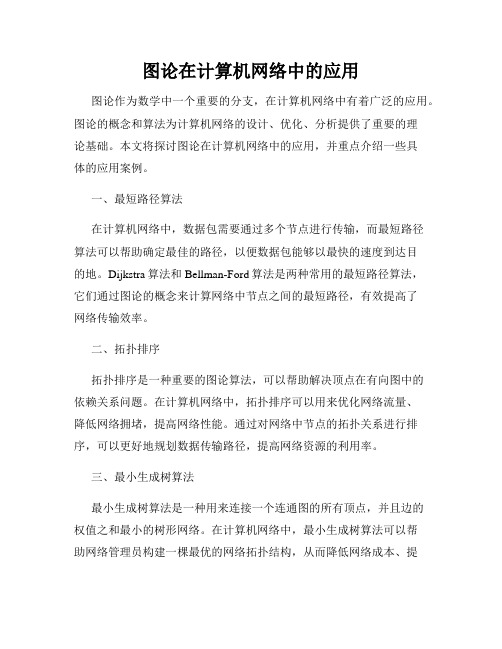
图论在计算机网络中的应用图论作为数学中一个重要的分支,在计算机网络中有着广泛的应用。
图论的概念和算法为计算机网络的设计、优化、分析提供了重要的理论基础。
本文将探讨图论在计算机网络中的应用,并重点介绍一些具体的应用案例。
一、最短路径算法在计算机网络中,数据包需要通过多个节点进行传输,而最短路径算法可以帮助确定最佳的路径,以便数据包能够以最快的速度到达目的地。
Dijkstra算法和Bellman-Ford算法是两种常用的最短路径算法,它们通过图论的概念来计算网络中节点之间的最短路径,有效提高了网络传输效率。
二、拓扑排序拓扑排序是一种重要的图论算法,可以帮助解决顶点在有向图中的依赖关系问题。
在计算机网络中,拓扑排序可以用来优化网络流量、降低网络拥堵,提高网络性能。
通过对网络中节点的拓扑关系进行排序,可以更好地规划数据传输路径,提高网络资源的利用率。
三、最小生成树算法最小生成树算法是一种用来连接一个连通图的所有顶点,并且边的权值之和最小的树形网络。
在计算机网络中,最小生成树算法可以帮助网络管理员构建一棵最优的网络拓扑结构,从而降低网络成本、提高网络可靠性。
Kruskal算法和Prim算法是两种常用的最小生成树算法,它们在网络设计中发挥着重要作用。
四、流量分析在计算机网络中,流量分析是一个重要的问题。
图论可以帮助分析网络中的数据流量,发现潜在的瓶颈和问题。
通过对网络流量的图论建模,可以更好地监控和管理网络,提高网络的安全性和性能。
总结:图论作为一门理论性较强的学科,在计算机网络中有着广泛的应用。
最短路径算法、拓扑排序、最小生成树算法和流量分析等都是图论在计算机网络中的重要应用领域。
图论的概念和算法为计算机网络的设计和优化提供了强有力的支持,帮助提高了网络的性能和效率。
随着计算机网络的发展和普及,图论在计算机网络中的应用将会变得越来越重要。
计算机科学中的图论和网络科学

计算机科学中的图论和网络科学图论是计算机科学中的一个重要分支,它研究顶点之间通过边相互联系的图形结构。
其应用在通讯、电子商务、社会网络等领域,被广泛使用。
随着时代的变迁,由于互联网的兴起和网络科学的兴盛,图论又与网络科学融合在了一起。
本文将深入探讨计算机科学中的图论和网络科学的基本概念和研究方向。
一、图论图论是一种研究顶点和边构成的图结构的数学分支。
在计算机科学领域,图论常常被用来分析不同的计算机网络,比如社交网络、信息网络、生物网络等等。
图结构可以用来表示很多现实场景,比如邮路图,城市道路、人际关系等等。
a. 图的基本概念在图论中,对于一个图结构,我们通常会有以下概念:·顶点(Vertex):一个图结构中的单独节点;·边(Edge):两个顶点之间的连线;·权重(Weight):边上的值,用于表示两个顶点之间的距离或代价等。
b. 图的类型在图论中,有许多不同的图类型,以用于解决不同的问题。
这里我们简单介绍几种常见的类型:·简单图(Simple Graph):没有自环和重边的图;·完全图(Complete Graph):所有的顶点两两之间都有边相连的图;·有向图(Directed Graph):边有方向的图;·加权图(Weighted Graph):边上有权值的图。
二、网络科学网络科学是一门新兴的学科,它研究各种网络之间的复杂性和特征。
网络科学广泛应用于社会、生物、信息、市场等不同领域,以帮助人们理解和预测这些领域中的现象和行为。
网络科学使用数学和电脑模拟等方法来研究各种网络,比如社交网络、互联网、生物网络等。
在网络科学的各个领域中,我们可以发现许多基于图论的算法和模型。
a. 网络的结构网络结构是网络科学的一个基本概念。
根据这个概念,网络可以分为以下类型:·随机图(Random Graph):网络中的节点和连接是完全随机的;·小世界网络(Small World Network):在这种网络结构中,任意两个节点之间的距离很短,通常是对数级别的;·无标度网络(Scale-Free Network):在这种网络结构中,一些节点会拥有更多的连接,而大多数节点只有很少的连接。
- 1、下载文档前请自行甄别文档内容的完整性,平台不提供额外的编辑、内容补充、找答案等附加服务。
- 2、"仅部分预览"的文档,不可在线预览部分如存在完整性等问题,可反馈申请退款(可完整预览的文档不适用该条件!)。
- 3、如文档侵犯您的权益,请联系客服反馈,我们会尽快为您处理(人工客服工作时间:9:00-18:30)。
If the edge (vi, vj) is in E(G), adj_mat[i][j]=1. If there is no such edge in E(G), adj_mat[i][j]=0.
The adjacency matrix for an undirected graph is symmetric; the adjacency matrix for a digraph need not be symmetric. Merits of adjacency matrix
0 1 3 2 1
0 2 3
6
Adjacent and Incident
If (v0, v1) is an edge in an undirected graph,
v0 and v1 are adjacent The edge (v0, v1) is incident on vertices v0 and v1 v0 is adjacent to v1, and v1 is adjacent from v0 The edge <v0, v1> is incident on v0 and v1 A graph may not have an edge from a vertex, i, back to itself. Such edges are known as self loops. A graph may not have multiple occurrences of the same edge. If we remove this restriction, we obtain a data object referred to as a multigraph. 0
A walk that does this is called Eulerian.
Graphs have been used in a wide variety of applications, including
analysis of electrical circuits finding shortest routes project planning the identification of chemical compounds social network analysis.
A tree is a graph that is connected and acyclic.
9
Connected Components in Directed Graph
Weakly Connected Component (WCC)
Ignore directionality and find the connected components
2
3
3
3
1
4
1
5
1
6
1
11
3
in: 1, out: 0
Adjacency Matrix
Let G=(V,E) be a graph with n vertices. The adjacency matrix of G is a two-dimensional n by n array, say adj_mat
2 G3
E(G1)={(0,1),(0,2),(0,3),(1,2),(1,3),(2,3)} E(G2)={(0,1),(0,2),(1,3),(1,4),(2,5),(2,6)} E(G3)={<0,1>,<1,0>,<1,2>}
5
Complete Graph (Clique)
A complete graph is a graph that has the maximum number of edges For undirected graph with n vertices, the maximum number of edges is n(n-1)/2 For directed graph with n vertices, the maximum number of edges is n(n-1) Examples
To determine the connection of vertices is easy n 1 The degree of a vertex is adj _ mat[i][ j ]
j 0
For a digraph, the row sum is the out_degree, while the column sum is the in_degree
0 1 3 G1 0 1
2 2
(iv)
8
0
0 1 2
1 3
2 1
0 2 3
2
(i)
(ii) (iii) (a) Some of the subgraph of G1
(iv)
0
0 1
0 1
0 1
2 G3
(i)
(ii) (iii) (b) Some of the subgraph of G3
Path, Cycle, and Connected Component
A path from vertex vp to vertex vq in a graph, G, is a sequence of vertices, vp, vi1, vi2, …, vin, vq,such that (vp, vi1), (vi1, vi2), …, (vin, vq) are edges in an undirected graph. The length of a path is the number of edges on it. A simple path is a path in which all vertices, except possibly the first and the last, are distinct. A cycle is a simple path in which the first and the last vertices are the same. In an undirected graph G, two vertices, v0, v1, are connected if there is a path in G from v0 to v1. A connected component, or simply a component, of an undirected graph is a maximal connected subgraph.
ind (vi ) A[ j , i ]
j 0
n 1
outd (vi ) A[i , j ]
j 0
12
n 1
Drawback of adjacency matrix
For all node-pairs, i and j, the path from node i to node j and the path from node j to node i must be the same
10
Degree
The degree of a vertex is the number of edges incident to that vertex For directed graph,
2
Euler’s Solution
Euler defined the degree of a vertex as the number of edges incident on it. He then showed that there is a walk starting at any vertex, going through each edge exactly once, and terminating at the starting vertex iff the degree of each vertex is even.
Strongly Connected Component (SCC)
For all node-pairs, i and j, there is a path from node i to node j and there is a path from node j to node i
Rescursively Strongly Connected Component (RSCC)
0 2
If <v0, v1> is an edge in a directed graph
Restrictions on graphs:
1
3
1
2
7
Subgraph
A subgraph of G is a graph G’ such that V(G’)V(G) and E(G’) E(G).
E.g. <v0, v1> represents an edge in which v0 is the tail and v1 is the head.
4
Sample Graphs
0 0 0
1
3 G1
2
3
1 4 G2
5
2
6
incomplete graph
1
complete graph V(G1)={0,1,2,3} V(G2)={0,1,2,3,4,5,6} V(G3)={0,1,2}
Graphs may be the most widely used of all mathematical structures.
